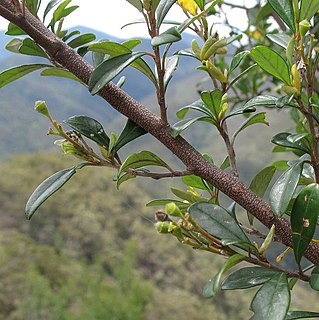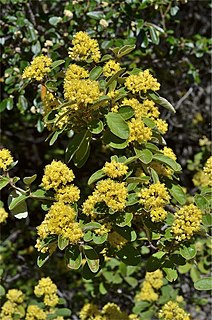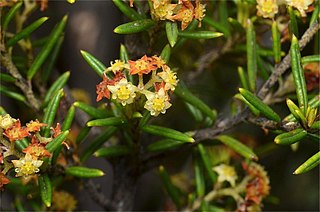
Spyridium globulosum, commonly known as basket bush, is a species of flowering plant in the family Rhamnaceae and is endemic to coastal areas in the south-west of Western Australia. It is a shrub with relatively large leaves and heads of flowers covered with whitish hairs.

Grevillea celata, commonly known as Nowa Nowa grevillea or Colquhoun grevillea, is a species of flowering plant in the family Proteaceae and is endemic to a restricted part of Victoria in Australia. It is an erect and open to low, dense shrub with oblong, broadly elliptic or linear leaves, and red and yellow, or red, white and apricot-coloured, sometimes all yellow flowers.

Pultenaea juniperina, commonly known as prickly bush-pea or prickly beauty is a species of flowering plant in the family Fabaceae and is endemic to south-eastern Australia. It is an erect, spiky shrub with hairy stems, linear to narrow elliptic leaves with stipules at the base, and yellow-orange and red flowers.

Pomaderris lanigera, commonly known as woolly pomaderris, is a species of flowering plant in the family Rhamnaceae and is endemic to south-eastern continental Australia. It is a shrub or small tree with hairy stems, lance-shaped to egg-shaped or elliptic leaves, and hemispherical clusters of yellow flowers.

Grevillea evanescens is a species of flowering plant in the family Proteaceae and is endemic to the south-west of Western Australia. It is an erect to spreading shrub with oblong to elliptic leaves and clusters of pale to bright red and cream-coloured flowers.

Bossiaea tasmanica is a species of flowering plant in the family Fabaceae and is endemic to Tasmania. It is a prostrate or low-lying shrub with spiny branches, elliptic to egg-shaped with the narrower end towards the base, and yellow and red to pink flowers.
Bossiaea alpina is a species of flowering plant in the family Fabaceae and is endemic to a small area in south-eastern Victoria, Australia. It is a diffuse shrub with oblong to elliptic leaves and bright yellow flowers arranged singly on the ends of branchlets.
Bossiaea spinescens is a species of flowering plant in the family Fabaceae and is endemic to the south-west of Western Australia. It is a slender, spreading or compact, spiny shrub with oblong to oval leaves and yellow and reddish-brown, pea-like flowers.
Hovea corrickiae, is a species of flowering plant in the family Fabaceae and is endemic to south-eastern Australia. It is a shrub or slender tree with densely hairy branchlets, narrowly egg-shaped or elliptic, dark green leaves with stipules at the base, and mostly pale to deep mauve, pea-like flowers.

Lasiopetalum drummondii is a species of flowering plant in the family Malvaceae and is endemic to the south-west of Western Australia. It is an erect, slender shrub with many densely hairy stems, egg-shaped or oblong leaves and white, pink and red flowers.

Pomaderris gilmourii is a species of flowering plant in the family Rhamnaceae and is endemic to Deua National Park in New South Wales. It is a shrub with hairy young stems, egg-shaped to elliptic leaves, and clusters of silvery buds and creamy-yellow flowers.
Pomaderris halmaturina, commonly known as Kangaroo Island pomaderris, is a species of flowering plant in the family Rhamnaceae and is endemic to southern continental Australia. It is a shrub with narrowly elliptic to egg-shaped leaves with toothed or wavy edges, and sparse panicles of hairy, yellowish-green flowers.

Pomaderris helianthemifolia is a species of flowering plant in the family Rhamnaceae and is endemic to south-eastern continental Australia. It is a bushy shrub with hairy young stems, narrowly elliptic to lance-shaped leaves with the narrower end towards the base, and small panicles of hairy yellowish flowers.

Pomaderris parrisiae is a species of flowering plant in the family Rhamnaceae and is endemic to southern New South Wales. It is a shrub to small, slender tree with silvery-hairy branchlets, elliptic to lance-shaped leaves and panicles of hairy, creamy-yellow flowers.

Pomaderris velutina, commonly known as velvety pomaderris or velvet pomaderris, is a species of flowering plant in the family Rhamnaceae and is endemic to south-eastern continental Australia. It is a slender shrub with rusty-hairy young stems, egg-shaped to oblong or more or less elliptic leaves, and loose panicles of pale yellow flowers.

Spyridium bifidum, commonly known as forked spyridium, is a species of flowering plant in the family Rhamnaceae and is endemic to South Australia. It is an erect shrub with densely softly-hairy young stems, wedge-shaped to linear leaves sometimes with a two-lobed tip, and densely woolly heads of white-velvety flowers.

Spyridium scortechinii is a species of flowering plant in the family Rhamnaceae and is endemic to eastern Australia. It is a shrub with egg-shaped to narrowly elliptic leaves, and dense heads of white, woolly-hairy flowers with brown bracts at the base.

Spyridium daltonii is a species of flowering plant in the family Rhamnaceae and is endemic to Victoria in Australia. It is a shrub with softly-hairy branchlets, linear to narrowly elliptic leaves, and small groups of hairy, yellowish flowers.
Spyridium fontis-woodii, commonly known as Woods Well spyridium, is a species of flowering plant in the family Rhamnaceae and is endemic to a small area of Coorong National Park in South Australia. It is a slender shrub with softly-hairy young stems, broadly egg-shaped to broadly heart-shaped leaves with the narrower end towards the base, and head of white to cream-coloured flowers.

Spyridium furculentum, commonly known as forked spyridium, is a species of flowering plant in the family Rhamnaceae and is endemic to a small area of Victoria in Australia. It is a shrub with softly-hairy young stems, Y-shaped leaves, and head of white to cream-coloured flowers.














